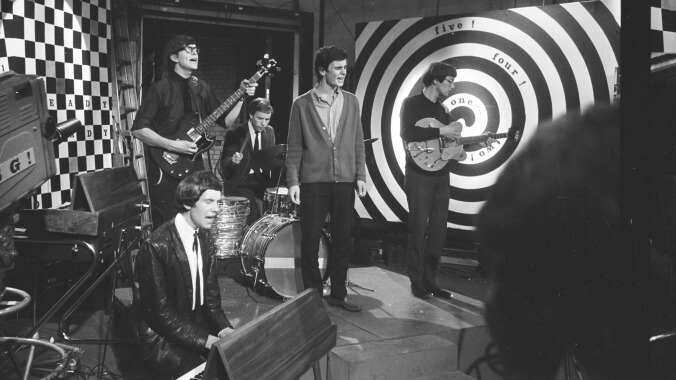Fake Zombies, dangerous triangles, and more Wiki Wormhole quick hits

We explore some of Wikipedia’s oddities in our 6,195,473-week series, Wiki Wormhole.
This week’s entry: Quick hits
What it’s about: Lots of things! Over the years, we’ve come across Wikipedia articles that fascinated or amused to some degree, but were too short to write a full column about. So for the next few weeks, we’re going to shake up the format, and move through our 6,195,473-part series a bit faster by tackling multiple subjects in brief.
Busta Rhymes Island: Woo ha, a pond in rural Massachusetts has got you all in check! Shrewsbury, Massachusetts, a town of around 35,000, is home to Mill Pond, and in that pond is an island about 40 feet across. Area man Kevin O’Brien took it upon himself to care for the island, and at some point around 2009, decided to name it Busta Rhymes Island. His logic being, the small island has, “rope-swinging, blueberries, and… stuff Busta would enjoy.” Courvoisier, wild blueberries—pretty much the same thing.
O’Brien has tried to register the name officially, but the United States Board on Geographic Names will not recognize landmarks named for living celebrities—their regulations stipulate that a person must be dead for five years before they can become a location’s namesake. He’s settled for getting Google Maps to recognize the name and circulating petitions for the change.
Post-Zombies: British Invasion group The Zombies are too well-known to merit a Wiki Wormhole, but their page does include one wild story that deserves to be told. After scoring hits with 1964’s “She’s Not There,” and “Tell Her No,” the band struggled, unable to produce a follow-up hit. When the first two singles from their second album, Odessey And Oracle (the title was misspelled by the cover artist and the band just went with it), flopped and their draw as a live act declined, the band broke up—four months before Odessey And Oracle’s U.K. release.
Although Odessey is now looked at as a classic of the psychedelic era, CBS Records initially declined to issue it in the United States. Producer Al Kooper eventually persuaded his bosses to reverse course, and one of the album’s singles, “Time Of The Season,” slowly grew in popularity and airplay until in 1969, a full year after the album was released, it was a full-blown hit in the U.S. CBS was eager to capitalize, but the band had moved on: Their songwriting core, Rod Argent and Chris White, had already formed a new band, Argent, (best known for their song “Hold Your Head Up”), so there was no chance of a reunion. Instead, the label set up not one, but two fake Zombies lineups to tour behind “Time Of The Season,” one from Michigan and one from Texas. After the tour, two members of the Texas group continued playing together under another name: ZZ Top.
Strangely, another fake Zombies lineup toured in 1988, because the group’s trademark on the name had lapsed and they were able to snap it up. They went so far as to hire a bassist with the same name as the real band’s drummer (Hugh Grundy), and pretend it was the same guy on a new instrument.
Danger Triangle of the Face: A phrase we can only hope we’ll see again in Band Name Bureau (the Year In Band Names spin-off from A.V. Club alum Kyle Ryan), the Danger Triangle of the Face comprises the mouth, nose, and upper lip. The area is so named because an infection in this area can spread to the brain, because a major vein that serves the front of the organ drains downward to the triangle. Most people have valves that prevent blood from flowing in the reverse direction, but some people don’t, leaving a chance that an infection in the Danger Triangle could spread upwards. It sounds like the odds of this happening to you are pretty low—we just like saying Danger Triangle of the Face and we so rarely get the opportunity.
Tomoe Gozen: According to legend, the first Japanese shogunate was founded with the help of a female samurai named Tomoe Gozen. Not enough is known about her to verify that she actually existed, (or to fill a full Wiki Wormhole article), but she’s been a figure of fascination for centuries, and her story has been retold in everything from 14th-century Japanese epic The Tale Of The Heike to video game Rise Of Kingdoms. Heike describes her as extremely beautiful, remarkably strong, and “a warrior worth a thousand, ready to confront a demon or a god.”
Her entire family served eventual Shogun Minamoto no Yoshinaka in various capacities—two of her brothers were generals in his army. Gozen herself supposedly commanded 300 samurai to victory over 2,000 rival soldiers in a battle in 1182. At the Battle of Awazu in 1184, she’s said to have decapitated the opposing army’s leader and presented his head to Yoshinaka.
Further Down the Wormhole: Gozen appears as a character on the podcast Film Reroll, a show where the hosts “play through your favorite movies as RPGs and totally ruin them.” While podcasts can tackle frivolous concepts, the medium has also become a valuable outlet for citizen journalism, in which people not employed as journalists nonetheless research, analyze, and report on newsworthy information.
Doing so without professional oversight can risk lapses in journalistic ethics, and can open up the citizen journalist to legal issues, including accusations of defamation. Writers of fiction have avoided defamation claims by using a work-around known as the Small Penis Rule. We’ll take a close look, (and get all of our not-entirely-safe-for-work quick-hit topics out of the way in one go) next week.